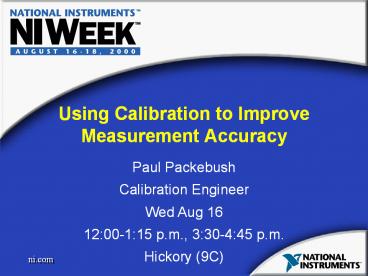Using Calibration to Improve Measurement Accuracy PowerPoint PPT Presentation
Title: Using Calibration to Improve Measurement Accuracy
1
Using Calibration to Improve Measurement Accuracy
Paul Packebush Calibration Engineer Wed Aug
16 1200-115 p.m., 330-445 p.m. Hickory (9C)
2
Calibration Accuracy Agenda
- Defining instrumentation
- Determining measurement accuracy
- Maintaining accuracy via calibration
- Proving your calibration
- Improving accuracy via system calibration
- Calibration services
3
Defining Instruments
- Processor/computer
- Measurement circuitry
- Power supply regulation
- Calibration circuitry
- Voltage reference source
- Onboard memory
4
Calibration Accuracy Terms
- Absolute accuracy
- Specifies the maximum possible uncertainty in a
measurement - Relative accuracy
- Difference between two or more measurements
- Calibration
- Process of determining and adjusting an
instruments accuracy
5
Taking Measurements
2V
/- 0.0002V
- Measurement uncertainty
- Uncertainty is defined by the devices Absolute
Accuracy
6
Calculating Accuracy
- Absolute accuracy (Input voltage x of
Reading) Offset System noise Temperature
drift
7
Example Calculation
- Absolute accuracy (Input voltage x of
Reading) Offset System noise Temperature
drift
- Device PCI-6052E Multifunction I/O Device
- Signal /- 2 V
- Environment 25 C
- For the /- 2.5 V input range
- of Reading 0.0304
- Offset 270.6 uV
- Noise 245.3 uV
- Absolute accuracy /- 1.12 mV
8
Calculating Accuracy(Multiple Components)
Stage 1
Stage 2
- Required for systems with multiple-gain stages
System accuracy
(Stage 1)2 (Stage 2)2
- Calculate accuracy for each stage
- Calculation based on signal level at the input of
that stage
9
Example Calculation
25 mV
Stage 1
Stage 2
System accuracy
(Stage 1)2 (Stage 2)2
- Stage 1 SCXI-1102 Amp/Mux
- Input Range 100 mV
- of Reading 0.02
- Offset 25 uV
- Noise 20 uV
- Stage 1 95 uV
- 0.38 RTI
Stage 2 PCI 6052E MIO Input Range 2.5 V of
Reading 0.0304 Offset 270 uV Noise
245 uV Stage 2 1.12 mV 0.04 RTI
System accuracy 0.382
10
Calculating Accuracy(Sensor)
- Convert sensor value to voltage
100 C ? 5.268 mV
- Calculate accuracy for that voltage
5.268 mV ? 0.5
- Convert absolute accuracy back to unit of measure
5.242 mV ? 99 C 5.294 mV ? 101 C
- Result
Accuracy 1 C
11
Effects of Environment
2.0001 V
1.9999 V
12
Effects of Time
0.01
Time
Error
24 Hrs
90 Days
1 Year
- 0.01
13
Effects of Time
0.01
Time
Error
24 Hrs
90 Days
1 Year
- 0.01
14
Temperature and Time Considerations
- Increased measurement uncertainty
- Lack of measurement consistency
- Reduced production yields
- Failure to meet ISO-9000 requirements
Resolve these issues with calibration
15
Calibration
- Component calibration
- Consider each component as individual units
- Internal calibration
- External calibration
- System calibration
- Consider entire system as a unit
- Compensates for other system errors
16
Component Calibration
- Calibration of individual system components
- Determines each components uncertainty
- With calibrated components, you can
- Calculate systems absolute accuracy
- Replace devices
- Change computers
17
Internal Calibration
- Adjusts the instrument to your environment
- Change in temperature
- Maintains uncertainty defined by calibration
- Requires an onboard reference source and
temperature sensor
18
External Calibration
- Defines uncertainty of a measurement device
- Can include adjustments
- Requires a traceable source
- Valid for a limited time
- Valid for temperature range
Not Possible with all devices
19
Proof of Calibration
- To meet ISO-9000 guidelines, your measurement
devices must be - Calibrated according to manufacturers
recommendations - Calibrated with an NIST traceable source
- Meet ANSI/NCSL Z540-1
- Documented with a traceable calibration
certificate
20
System Calibration
- Referred to as end-to-end calibration
- Reduces system measurement uncertainty
- Cables, software, sensor
- Apply adjustments in software
- Cannot change system components
21
Performing System Calibration
Source
Y AX2 BX C
- Apply a traceable source
- Take measurements across your input range
- Create a compensation function
- Apply the compensation function to all future
measurements
22
Calibration Services
- Calibration certificates
- Basic certificates
- Detailed certificates
- Worldwide calibration services
- Metrology lab support
- Manual procedures
- Calibration executive automated software
23
Measurement Ready Instrumentation
- Traceable calibration certificates
- Absolute accuracy information
- System calibration
24
For More Information
ni.com/calibration
- Application notes
- Manual calibration procedures
- National Instruments calibration services
- Tutorials
- System calibration procedures
- Third party calibration houses

